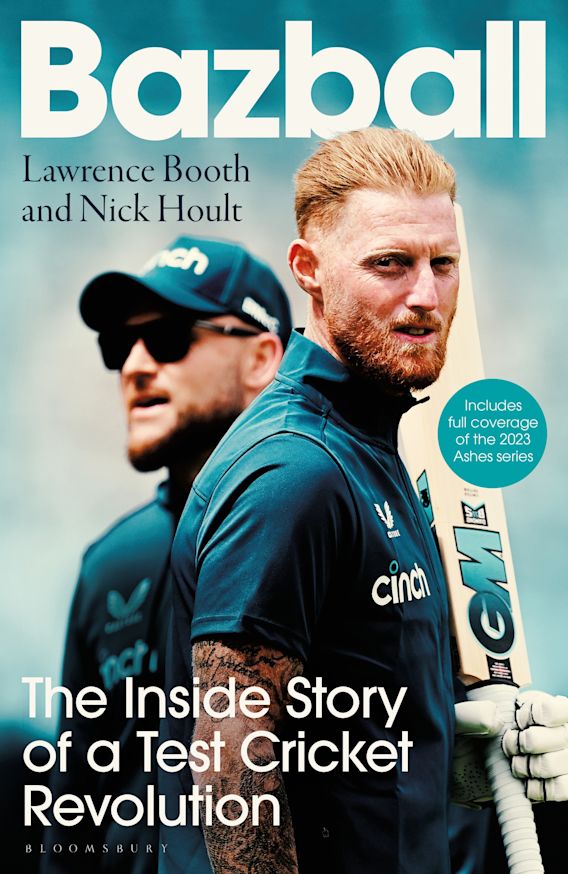By Lawrence Booth and Nick Hoult, Bloomsbury, pp 341, £22, ISBN 9781526672087

In the previous journal I had the pleasure to review White Hot, an analysis of the development of the England white-ball teams to the exalted status of double World Champions. From the same publisher, but different writers, comes a parallel analysis of the transformation of the England Test team, from the low points of the 2021-22 Ashes series and the defeat in the Caribbean, to the memorable victories against New Zealand, South Africa and India and the series win in Pakistan only a few months later, culminating with one of the classic Ashes contests in the summer of 2023.
The popular image of Bazball is that it means T20 cricket in the five-day game. The analysis by two of cricket’s most experienced journalists delivers a much more subtle and meaningful definition. Players are encouraged to play their natural game (being ‘authentic’, as the current management jargon has it), to enjoy the game (linking the player with the little boy who first fell in love with cricket), and to have the freedom to fail. The net result is that today’s professionals – at least at international level – play with something of the panache of the ‘gentlemen’ cricketers of the Golden Age, and it is surely no accident that the spirit of Jessop is invoked more than once. It is interesting to note that, where many jaded professionals notoriously welcome a rainy day, the cricketers interviewed for the book speak of their excitement on opening the curtains to see the sun shining.
However, the concept does not simply encapsulate a set of batting principles. Something of the same ethos is also applied to bowling, with the emphasis on taking wickets rather than keeping runs down. So a spinner is not necessarily removed from the attack if he is hit for a few boundaries, although equally, Ben Stokes has declined requests from nervous bowlers for a more protective field, preferring to encourage stroke play that offers more chance of a wicket.
The vexed question of the wicketkeeper is one area where Bazball does not seem to have provided an answer, and this is discussed at some length in the book. Instinctively, one would expect Bazball to favour the batting flair of Jonny Bairstow over the wicketkeeping artistry of Ben Foakes, and this does appear to be the current direction of travel. Yet for the early stages of Bazball, Foakes was the chosen keeper while Bairstow played as a specialist batsman, and it was the success of Harry Brook, rather than the batting style of Ben Foakes, that led to the selection of Bairstow as England’s wicketkeeper-batsman, at the start of the 2023 season. The authors note that, while Foakes has often proved an assured batsman at international level, his strike rate is only half that of Bairstow. Nonetheless, one feels that this is an area where the jury is still out.
The authors have interviewed and profiled many of the key figures in Bazball – indeed, its opening chapters are almost a mini-biography of Brendon McCullum – which gives additional authority to the account. Many of those interviewed believe that the principles of Bazball are now firmly established in English cricket. It remains to be seen whether the spirit permeates into the county game, and much will depend on the quality of the pitches, the scheduling of the County Championship and the willingness of county captains to take risks. Whatever happens, however, Bazball has delivered the most exciting series of Tests in my lifetime.
As well as a detailed assessment of the origins and impact of Bazball, the book provides an account of the 2023 Ashes series, which ranks with 1981 and 2005 as one of the most closely-fought and exciting series in my memory, although sadly contested largely behind a paywall that limited its impact on the national consciousness. In the past, a series like this would have spawned a plethora of books, and it may yet do so; this one was published in October 2023, only three months after the series ended. While it is perhaps difficult to imagine Neville Cardus or Jack Fingleton beginning one of their books with an analysis of the strike rates of the two sides, this is nonetheless a book in that worthy tradition.
As both an account of the principles that have transformed the England game, and the story of the 2023 Ashes, this is a thoroughly enjoyable read.
Richard Lawrence
